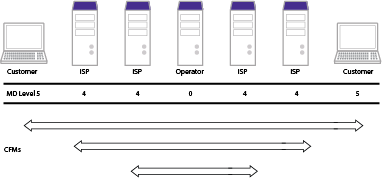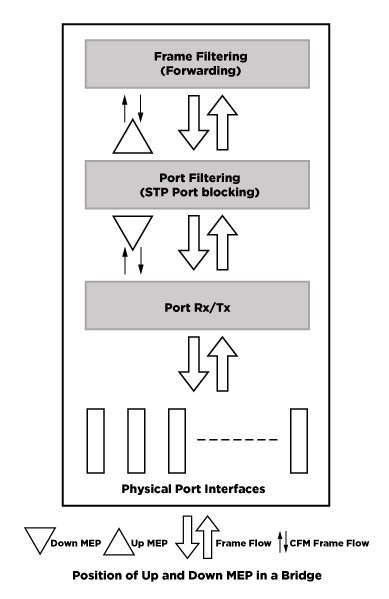CFM Overview
You can create hierarchical networks, or domains, and test connectivity within a domain by sending Layer 2 messages, known as CCM.

Note
Extreme Networks uses values defined in IEEE 802.1Q-2011 for the MAC addresses and Ethernet type for CFM.

Note
The arrows in the above figure indicate the span that CCM messages take, not the direction. (See CFM UP and DOWN MEP at the Logical Level for more information on spans for CCM messages.) This has been removed until the missing xref can be fixed.- Maintenance domains, or domains
- Maintenance domain (MD) level; a unique hierarchical numeric value for each domain
- Maintenance associations (MAs)
- Maintenance points (MPs) and MEP, which are one of the following types:
- UP MEPs
- DOWN MEPs
- Maintenance intermediate points (MIPs)

Note
The CFM filter function (CFF) is no longer supported from ExtremeXOS 12.1. The functionality of CFF is implicitly performed by MEPs.An UP MEP sends CFM frames toward the frame filtering entity, which forwards the frames to all other ports of a service instance other than the port on which the UP MEP is configured. This is similar to how the frame filtering entity forwards a normal data frame, taking into account the port's STP state. For an UP MEP, a CFM frame exits from a port if only if the STP state of the port is in the forwarding state.
A DOWN MEP sends CFM frames directly to the physical medium without considering the port STP state. For a DOWN MEP, a CFM frame exits from a port even if the port STP state is in blocking state.
CFM UP and DOWN MEP at the Logical Level shows the concept of UP and DOWN MEP at logical level:

You must have at least one MP on an intermediate switch in your domain. Ensure that you map and configure all ports in your domain carefully, especially the UP MEPs and the DOWN MEPs. If these are incorrectly configured, the CCMs are sent in the wrong direction in your network, and you will not be able to test the connectivity within the domain.

Note
Domains may cross VR boundaries; domains are not virtual router-aware.You assign each domain an MD level, which functions in a hierarchy for forwarding CFM messages. The MD levels are from 0 to 7. The highest number is superior in the CFM hierarchy.
- 5 to 7 for end users
- 3 and 4 for Internet service providers (ISPs)
- 0 to 3 for operators (entities carrying the information for the ISPs)
All CFM messages with a superior MD level (numerically higher) pass throughout domains with an inferior MD level (numerically lower). CFM messages with an inferior MD level are not forwarded to domains with a superior MD level. Refer to the following table for an illustration of domains with hierarchical MD levels.
| MD level | 0 | 1 | 2 | 3 | 4 | 5 | 6 | 7 |
| Use | Operator | Service provider | Customer | |||||
| Superiority | Most inferior | < ----- Inferior / Superior ----- > | Most superior | |||||
Within a given domain, you create maintenance associations (MAs). Extreme Networks‘ implementation of CFM associates MAs with service instances (a service instance can be a VLAN, VMAN, BVLAN, or SVLAN). All of the ports in that VLAN service instance are now in that MA and its associated domain. In general, you should configure one MIP on each intermediate switch in the domain and a MEP on every edge switch.
Each MA associates with one service instance, and a service instance can be associated with more than one MA. The MA is unique within the domain. One switch can have 8 domains, 128 ports, and 256 associations (see Supported Instances for CFM).

Note
You cannot associate the Management VLAN with an MA or a domain.You assign the MPs to ports: UP MEPs, DOWN MEPs, and MIPs. These various MPs filter or forward the CFM messages to test the connectivity of your network.
Each configured MEP periodically sends out a Layer 2 multicast or unicast CCM message.
- The DOWN MEPs sends out a single CCM message.
- The UP MEPs potentially sends the CCM message to all ports on the service instance (MA)—except the sending port—depending on the MPs configured on the outgoing ports.

Note
Ensure that you configured the UP and DOWN MEPs correctly, or the CCMs will flow in the wrong direction through the domain and not allow connectivity testing.MIPs define intermediate points within a domain. MIPs relay the CCM messages to the next MIP or MEP in the domain.
You configure the time interval for each MEP to send a CCM. We recommend setting this interval for at least one second. Each MEP also makes a note of what port and what time it received a CCM. This information is stored in the CCM database.
Each CCM has a time-to-live (TTL) value also noted for that message. This TTL interval is 3.5 times the CCM transmission interval you configured on the switch that is originating the CCM. After the TTL expires, the connectivity is considered broken, and the system sends a message to the log. One important result of the continual transmission of CCM frames is that the MAC address of the originating MEP is known to all MPs in the association.

Note
All MEPs in an MA must be configured with the same CCM transmission interval.The MD values are from 0 to 7; in the hierarchy, the MD level of 0 is lowest and 7 is highest.
- UP MEP and MIP
- DOWN MEP with neither UP MEP nor MIP
- MA can have either up MEP or down MEP and not both.
- MA can have multiple Down MEPs.
- Only one Up MEP per MA.
- MA can have both up MEP and MIP.
- MA cannot have MIP if down MEP is present.
- Down MEPs on regular ports are created in hardware for all CCM intervals for platforms that support CFM in hardware (ExtremeSwitching X460-G2).
- Up MEPs and MEPs on LAG ports are created in software with CCM intervals 100 msec–600000 sec on all platforms.
- Dynamic Remote MEP learning is not supported for the MEPs created in hardware. You must explicitly create static Remote MEPs.
- Sender-Id-IP Address cannot be configured for the MEPs created in hardware.
- Unicast CCM transmission is not supported by the MEPs created in hardware.
- Domain name format should be of string type to create any MEPs in hardware in that domain.
- The CCM transmission state is disabled by default for the MEPs created in hardware by the CFM user interface.
- The CCM transmission state is enabled by default for the MEPs created in hardware by CFM clients like ERPS.
- The hardware Remote MEP status appears in show cfm detail. It is also forwarded to the client if created by a client like ERPS.
- CFM objects like domain, association, MEP, Remote MEP created by a client are not saved by dot1ag.

Note
An MA can have an UP MEP in one switch and a DOWN MEP on another switch for the same MA.
